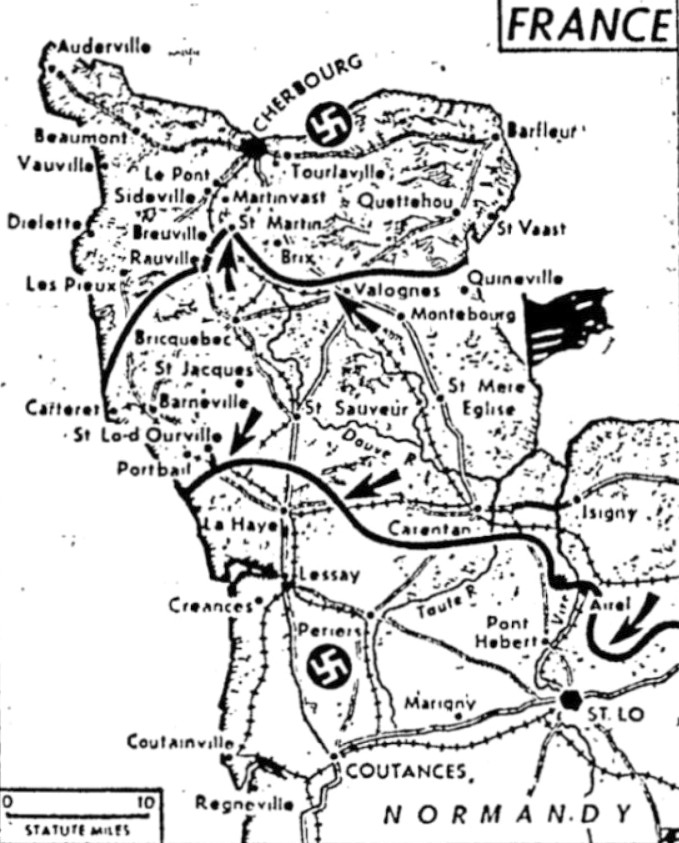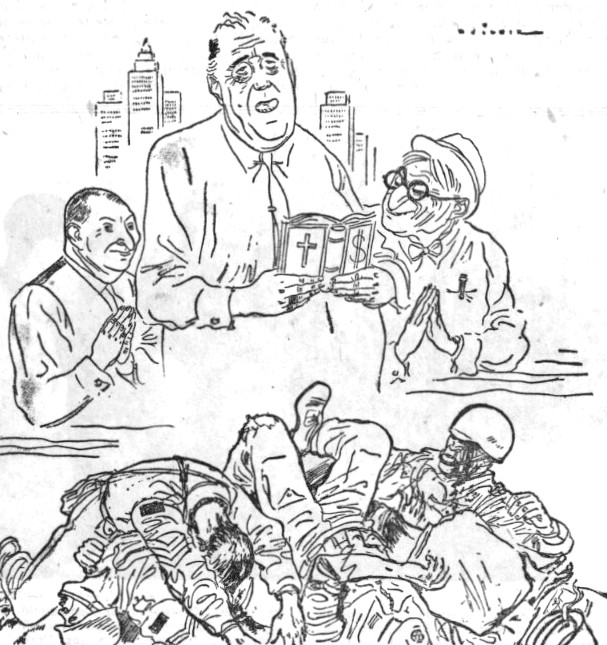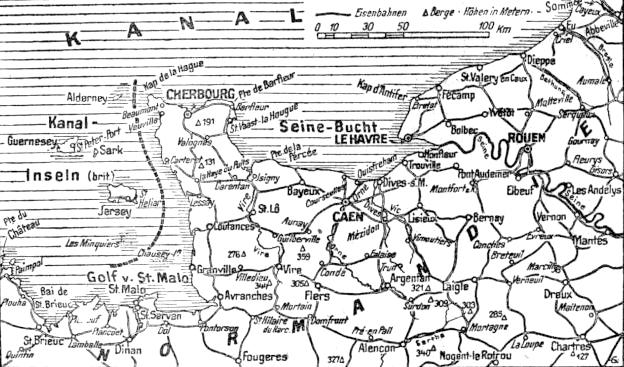YANKS FIGHTING INSIDE CHERBOURG
Powerful assault overcomes Nazi defenses in suburbs – full of city due hourly
Possibly 50,000 Germans face surrender or death
Allies press toward Cherbourg

Enlarging the wedge driven across the Normandy Peninsula to cut off the port of Cherbourg from the rest of France, Allied forces were reported within a few miles of the city in the vicinity of Saint-Martin. Arrows on map indicate direction of Allied drives.
SHAEF, London, England (AP) –
U.S. troops smashed within 1,500 yards – less than a mile – of Cherbourg’s waterfront today, driving between two fortress bastions under cover of air and artillery bombardment.
The fall of the great supply port seemed only a matter of hours tonight.
The piledriver offensive crashed through the suburbs along the inland road between Fort du Roule and Fort Octeville, Nazi strongpoints shuddering under bombs as well as leaflets calling on the trapped Nazis to surrender.
Nazi demolition squads worked feverishly to cripple the port – through which the Allies could pour a flood of men and supplies into Normandy.
Other advances
Another force rolling the trapped Germans back on the left flank seized Acqueville, at the base of Cap de la Hague, the land finger jutting northwest of Cherbourg and possible offering a chance of escape by sea.
Troops on the right flank advanced beyond Valognes, and Supreme Headquarters declared “good progress” was made toward the prize harbor today.
Supported by powerful artillery and air bombardment, veteran U.S. troops assaulted Fort du Roule, within a mile of Cherbourg’s docks, and Fort Octeville, bastion two miles in front of the military harbor area, blasted by Nazi demolitions.
Last-ditch stand
The Germans staged a last-ditch defense in these strongpoints, and fighting was reported in the built-up suburban section of France’s third largest port.
Eighty Nazi tanks have been destroyed by the Allied liberating armies to date, Supreme Headquarters said.
Heavy fighting was reported in the Tilly-sur-Seulles area near the center of the front, and a U.S. spearhead to the west had pushed within two miles of Saint-Lô, communications hub of Normandy.
The assault upon the two forts at Cherbourg sprang forward from Saint-Martin-le-Gréard, four miles south of the port.
Fort de Roule, a major key to control of the besieged German stronghold, stands atop a 450-foot hill.
The French worked for more than a century building up Cherbourg’s forts and defenses and the Germans are now making a last stand in the inner ring – which embraces part of the city itself.
Smoke hung over the city as the trapped German defenders carried out hurried demolitions in the strategic harbor, now in plain view of the attacking U.S. troops.
Escape cut off
German defenses have stiffened and there are indications the Nazi High command has ordered a house-to-house fight by some 25,000 to 50,000 Germans now left with virtually no chance to escape. Allied broadcasts last night urged the trapped garrison to surrender.
Although the three main roads to Cherbourg from the south run into one main highway bottleneck just outside the city, U.S. troops were apparently closing in from three sides – south, west, and east.
Communiqué No. 31 from Supreme Headquarters this morning announced that the towns of Valognes, Les Pieux, Couville and Rauville-la-Bigot were in Allied hands, but the advance U.S. line runs some distance beyond these points.
The suburban and city area which now has become a battlefield has an estimated population of 60,000. The population of the city proper, according to latest reports, is approximately 33,400 and an additional 27,000 live in the suburbs.
Doubt sea shelling
Despite German reports, the Supreme Command said it has no knowledge that Allied warships were shelling Cherbourg from the sea and declared such an attack was unlikely.
The port is protected by seven heavy coastal forts which should be much simpler to take by land assault than from the sea.
Only patrol activity was reported elsewhere on the Normandy beachhead except in the Tilly-sur-Seulles area.
The British announced the capture of Onchy, three and a half miles southwest of Tilly. At the same time, the Germans launched three heavy counterattacks on the newly-taken British strongpoint of Hottot, two miles south of Tilly. The attacks were reported held, but the situation in the village itself was obscure.
The Caen area even farther to the east was quiet.
A gale continued to blow in the Channel. Six-foot waves whipped over the invasion beaches, making unloading of supplies impossible for the time being.
Bad weather hampered aircraft over the battle area, but fighter-bombers blasted Cherbourg guns and forts. Many of the missions took to the air from landing grounds in Normandy.




